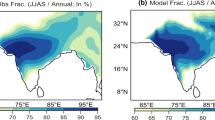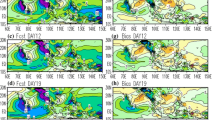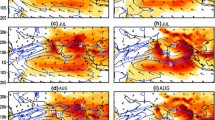Abstract
Predictability of Ethiopian Kiremt rainfall (June to September: JJAS) and forecast skill of the European Centre for Medium-Range Weather Forecasts (ECMWF) fifth-generation seasonal forecast system 5 (SEAS5) is explored during 1981–2019. The first empirical orthogonal function of observed rainfall explains 50.6% of the total variability and is characterized by positive rainfall anomalies largely confined over the northwestern and central-western regions of Ethiopia. Consequently, a Kiremt rainfall index (KRI) is defined for this region. The correlation coefficient (CC) between the observed and predicted KRI is 0.68 and 0.53 for May and April starts, respectively. Composite analysis of sea surface temperature (SST) and lower-level circulation based on excess and deficit years of Kiremt rains shows that the El Niño Southern–Oscillation is the main modulator of the Kiremt rainfall variability. The CC between KRI and Niño3.4 index is − 0.62, indicating that El Niño is accompanied by below-normal Kiremt rainfall, while La Niña is accompanied by above-normal amounts. The fifth generation of ECMWF atmospheric reanalysis (ERA5) shows that excess (deficit) Kiremt rainfall anomalies are associated with an anomalous low (high) pressure centered over northeast Arabian Peninsula and an anomalous in-phase (reverse) low-level Somali Jet. SEAS5 reproduces the spatial and temporal components of observed Kiremt rainfall variability, including the main climatic features associated with excess and deficit Kiremt rainfall in May and April starts. However, certain important observed features like above-normal SSTs in the Gulf of Guinea are not well predicted. Results indicate that Kiremt rains has some potential predictability and SEAS5 shows a moderate forecast skill. Probabilistic analysis shows highest values where predictability and deterministic skill are also highest.












Similar content being viewed by others
References
Alhamshry A, Fenta AA, Yasuda H, Kimura R, Shimizu K (2020) Seasonal rainfall variability in Ethiopia and its long-term link to global sea surface temperatures. Water 12(1):55. https://doi.org/10.3390/w12010055
Blum AG, Zaitchik B, Alexander S, Wu S, Zhang Y, Shukla S, Block P (2019) A grand prediction: communicating and evaluating 2018 summertime Upper Blue Nile rainfall and streamflow forecasts in preparation for Ethiopia’s new dam. Front Water 1:3
Degefu MA, Rowell DP, Bewket W (2017) Teleconnections between Ethiopian rainfall variability and global SSTs: observations and methods for model evaluation. Meteorol Atmos Phys 129:173–186. https://doi.org/10.1007/s00703-016-0466-9
Dinku T, Funk C, Peterson P, Maidment R, Tadesse T, Gadain H, Ceccato P (2018) Validation of the CHIRPS satellite rainfall estimates over eastern Africa. Q J R Meteorol Soc 144(S1):292–312. https://doi.org/10.1002/qj.3244
Diro GT, Grimes DIF, Black E (2011a) Teleconnections between Ethiopian summer rainfall and sea surface temperature: part I-observation and modelling. Clim Dyn 37:103–119. https://doi.org/10.1007/s00382-010-0837-8
Diro GT, Grimes DIF, Black E (2011b) Teleconnections between Ethiopian summer rainfall and sea surface temperature: part II. Seasonal forecasting. Clim Dyn 37:121–131. https://doi.org/10.1007/s00382-010-0896-x
Ehsan MA, Almazroui M, Yousef A, Enda OB, Tippett MK, Kucharski F, Alkhalaf AK (2017) Sensitivity of AGCM simulated regional summer precipitation to different convective parameterizations. Int J Climatol 37:4594–4609
Ehsan MA, Kucharski F, Almazroui M (2020a) Potential predictability of boreal winter precipitation over central-southwest Asia in the North American multi-model ensemble. Clim Dyn 54:473–490. https://doi.org/10.1007/s00382-019-05009-3
Ehsan MA, Tippett MK, Kucharski F, Almazroui M, Ismail M (2020b) Predicting peak summer monsoon precipitation over Pakistan in ECMWF SEAS5 and North American multimodel ensemble. Int J Climatol. https://doi.org/10.1002/joc.6535
Fekadu K (2015) Ethiopian seasonal rainfall variability and prediction using canonical correlation analysis (CCA). Earth Sci 4:112–119
Fernandes K, Muñoz AG, Villegas JR, Agudelo D, Herrera LL, Esquivel A, Espinoza JR, Prager SD (2020) Improving seasonal Precipitation Forecasts For Agriculture In the Orinoquía Region of Colombia. Weather Forecast 35(2):437–449. https://doi.org/10.1175/WAF-D-19-0122.1
Funk CC, Peterson P, Landsfeld M, Pedreros D, Verdin J, Shukla S, Husak G, Rowland J, Harrison L, Hoell A, Michaelsen J (2015) The climate hazards group infrared precipitation with stations—a new environmental record for monitoring extremes. Sci Data 2:150066. https://doi.org/10.1038/sdata.2015.66
Gamachu D (1988) Some patterns of altitudinal variation of climatic elements in the mountainous regions of Ethiopia. MRD 8:131–138. https://doi.org/10.2307/3673439
Gissila T, Black E, Grimes D, Slingo J (2004) Seasonal forecasting of the Ethiopian summer rains. Int J Clim 24:1345–1358
Gleixner S, Keenlyside NS, Demissie TD, Counillon F, Wang Y, Viste E (2017) Seasonal predictability of Kiremt rainfall in coupled general circulation models. Environ Res Lett 12:114016
Goddard L, Dilley M (2004) El Niño: catastrophe or opportunity. J Clim 18:651–665. https://doi.org/10.1175/JCLI-3277.1
Gubler S, Sedlmeier K, Bhend J, Avalos G, Coelho CAS, Escajadillo Y, Jacques-Coper M, Martinez R, Schwierz C, Spirig MC (2020) Assessment of ECMWF SEAS5 Seasonal Forecast Performance over South America. Wea Forecast 35(2):561–584. https://doi.org/10.1175/WAF-D-19-0106.1
Hersbach H et al (2020) The ERA5 global reanalysis. Q J R Meteorol Soc 146:1999–2049. https://doi.org/10.1002/qj.3803
Johnson SJ et al (2019) SEAS5: the new ECMWF seasonal forecast system. Geosci Model Dev 12:1087–1117. https://doi.org/10.5194/gmd-12-1087
Jury MR (2014) Evaluation of coupled model forecasts of Ethiopian highlands summer climate. Adv Meteorol. https://doi.org/10.1155/2014/894318
Jury MR (2019) Global wave-2 structure of El Niño–Southern Oscillation-modulated convection. Int J Climatol. https://doi.org/10.1002/joc.5963
Kalnay E et al (1996) The NCEP/NCAR 40-year reanalysis project. Bull Am Meteorol Soc 77:437–470
Kang IS, Shukla J (2006) Dynamic seasonal prediction and predictability of the monsoon. In: Wang B (ed) The Asian monsoon. Springer-Paraxis, Chichester
Kendall MG (1975) Rank correlation methods. Griffin, London
Kirtman BP et al (2014) The North American multimodel ensemble: phase-1 seasonal-to-interannual prediction; phase-2 toward developing intraseasonal prediction. Bull Am Meteorol Soc 95:585–601. https://doi.org/10.1175/BAMS-D-12-00050.1
Korecha D, Barston AG (2007) Predictability of June–September rainfall in Ethiopia. Mon Weather Rev 135:628–650. https://doi.org/10.1175/MWR3304.1
Korecha D, Sorteberg A (2013) Validation of operational seasonal rainfall forecast in Ethiopia. Water Resour Res. https://doi.org/10.1002/2013WR013760
Krishnamurthy L, Muñoz ÁG, Vecchi GA, Msadek R, Wittenberg AT, Stern B, Gudgel R, Zeng F (2019) Assessment of summer rainfall forecast skill in the Intra-Americas in GFDL high and low-resolution models. Clim Dyn 52:1–18. https://doi.org/10.1007/S00382-018-4234-Z
MacLeod D (2019) Seasonal forecast skill over the Greater Horn of Africa: a verification atlas of system 4 and SEAS5. Part 1: Precipitation. ECMFW Tech. rep. https://www.ecmwf.int/node/18906. Accessed 19 Oct 2020
Mann HB (1945) Nonparametric tests against trend. Econometrica 13:245–259
Mason SJ, Graham NE (2002) Areas beneath the relative operating characteristics (ROC) and relative operating levels (ROL) curves: statistical significance and interpretation. Q J R Meteorol Soci 584:2145–2166
Mason SJ, Weigel AP (2009) A generic forecast verification framework for administrative purposes. Mon Weather Rev 137:331–349. https://doi.org/10.1175/2008MWR2553.1
Mason SJ, Tippet MK, Song L, Muñoz ÁG (2020) Climate predictability tool version 16.5.2. Columbia University Academic Commons. https://doi.org/10.7916/d8-1tdx-w906. Accessed 30 Sep 2020
Murphy AH (1969) On the ranked probability skill score. J Appl Meteorol 8:988–989
Murphy AH (1971) A note on the ranked probability skill score. J Appl Meteorol 10:155–156
Nicholson SE (2018) The ITCZ and the seasonal cycle over Equatorial Africa. Bull Am Meteorol Soc 9:337–348. https://doi.org/10.1175/BAMS-D-16-0287.1
Rayner NA, Parker DE, Horton EB, Folland CK, Alexander LV, Rowell DP, Kent EC, Kaplan A (2003) Global analyses of sea surface temperature, sea ice, and night marine air temperature since the late nineteenth century. J Geophys Res 108:4407
Roussi A (2019) Nations clash over giant Nile dam. Nature 574:159–160. https://doi.org/10.1038/d41586-019-02987-6
Rowell DP, Folland CK, Maskell K, Ward MN (1995) Variability of summer rainfall over Tropical North Africa (1906–92) Observations and modelling. Q J R Meteorol Soc 121:669–704
Segele ZT, Lamb PJ (2005) Characterization and variability of Kiremt rainy season over Ethiopia. Meteor Atmos Phys 89:153–180
Segele ZT, Lamb P, Leslie L (2009) Large-scale atmospheric circulation and global sea surface temperature associations with Horn of Africa June–September rainfall. Int J Climatol 29:1075–1100
Shanko D, Camberlin P (1998) The effect of the southwest Indian Ocean tropical cyclones on Ethiopian drought. Int J Climatol 18:1373–1378
Shukla S, Roberts J, Hoell A, Funk CC, Robertson F, Kirtman B (2019) Assessing North American multimodel ensemble (NMME) seasonal forecast skill to assist in the early warning of anomalous hydrometeorological events over East Africa. Clim Dyn 53:7411–7427
Swain A (1997) Ethiopia, the Sudan, and Egypt: the Nile River Dispute. J Mod Afr Stud 35(4):675–694
Walker DP, Birch CE, Marsham JH, Scaife AA, Grahan RJ, Segele ZT (2019) Skill of dynamical and GHACOF consensus seasonal forecasts of East African rainfall. Clim Dyn 53:4911–4935
Weigel AP, Liniger MA, Appenzeller C (2007) The discrete brier and ranked probability skill scores. Mon Weather Rev 135:118–124. https://doi.org/10.1175/MWR3280.1
Wilks DS (2006) Statistical methods in the atmospheric sciences, 2nd edn. Elsevier Publishers, New York
WMO (2017) WMO Guidelines on the Calculation of Climate Normals. WMO-No. 1203. https://public.wmo.int/. Accessed 05 June 2021
Acknowledgements
The authors acknowledge the Copernicus Climate Data Store for providing System-5 data. We also acknowledge the agencies that support the NMME-Phase II system, and we thank the climate modeling groups (Environment Canada, NASA, NCAR, NOAA/GFDL, NOAA/NCEP, and University of Miami) for producing and making available their model output. NOAA/NCEP, NOAA/CTB, and NOAA/CPO jointly provided coordinating support and led development of the NMME-Phase II system. We also acknowledge IRIDL for maintaining and hosting NMME datasets (http://iridl.ldeo.columbia.edu/SOURCES/.Models/.NMME/). This work is undertaken as part of the Columbia World Project, ACToday, Columbia University in the City of New York. The authors are grateful to three anonymous reviewers for insightful comments that improved the original version of the manuscript.
Author information
Authors and Affiliations
Corresponding author
Additional information
Publisher's Note
Springer Nature remains neutral with regard to jurisdictional claims in published maps and institutional affiliations.
Supplementary Information
Below is the link to the electronic supplementary material.
Rights and permissions
About this article
Cite this article
Ehsan, M.A., Tippett, M.K., Robertson, A.W. et al. Seasonal predictability of Ethiopian Kiremt rainfall and forecast skill of ECMWF's SEAS5 model. Clim Dyn 57, 3075–3091 (2021). https://doi.org/10.1007/s00382-021-05855-0
Received:
Accepted:
Published:
Issue Date:
DOI: https://doi.org/10.1007/s00382-021-05855-0




